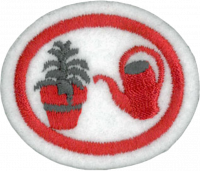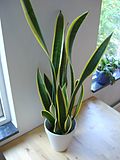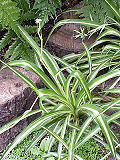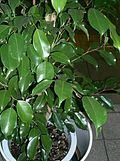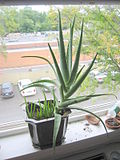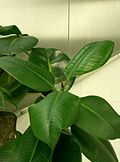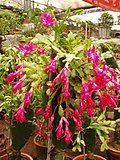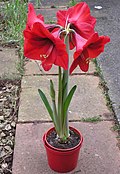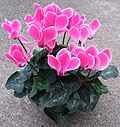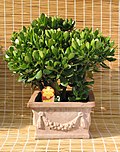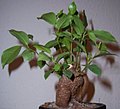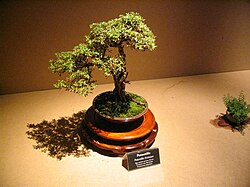|
|
| (6 intermediate revisions by 2 users not shown) |
| Line 76: |
Line 76: |
| | {{ansreq|page={{#titleparts:{{PAGENAME}}|2|1}}|num=4}} | | {{ansreq|page={{#titleparts:{{PAGENAME}}|2|1}}|num=4}} |
| | <noinclude></noinclude> | | <noinclude></noinclude> |
| − | <!-- 4. A la mayoría de plantas caseras les gusta la temperatura entre 65° a 75° F (18° a 22° C ). Nombrar una que requiere una habitación fresca de 45° a 55° F (7° a 13° C). --> | + | <!-- 4. A la mayoría de plantas caseras les gusta la temperatura entre 65 a 75° F (18 a 22° C ). Nombrar una que requiere una habitación fresca de 45 a 55° F (7 a 13° C). --> |
| | El '''ciclamen''' (también conocido como artánita o pan de puerco) comúnmente vendido por los floristas es ''C. persicum'', que se congela fácil. Los cultivares seleccionados del ciclamen pueden tener flores blancas, rosadas brillantes, rojas o púrpuras. Mientras que florecen, los ciclámenes de los floristas se deben mantener debajo de 20° C (68° F), con las temperaturas de la noche preferiblemente entre 6,67 °C a 15 °C (44 °F a 59 °F). Las temperaturas más de 20 °C (68 °F) pueden hacer que la planta permanezca inactiva. | | El '''ciclamen''' (también conocido como artánita o pan de puerco) comúnmente vendido por los floristas es ''C. persicum'', que se congela fácil. Los cultivares seleccionados del ciclamen pueden tener flores blancas, rosadas brillantes, rojas o púrpuras. Mientras que florecen, los ciclámenes de los floristas se deben mantener debajo de 20° C (68° F), con las temperaturas de la noche preferiblemente entre 6,67 °C a 15 °C (44 °F a 59 °F). Las temperaturas más de 20 °C (68 °F) pueden hacer que la planta permanezca inactiva. |
| | | | |
| Line 109: |
Line 109: |
| | {{CloseReq}} <!-- 7 --> | | {{CloseReq}} <!-- 7 --> |
| | {{ansreq|page={{#titleparts:{{PAGENAME}}|2|1}}|num=8}} | | {{ansreq|page={{#titleparts:{{PAGENAME}}|2|1}}|num=8}} |
| − | <noinclude><div lang="en" dir="ltr" class="mw-content-ltr"> | + | <noinclude></noinclude> |
| − | </noinclude> | + | <!-- 8. Nombrar dos plantas de casa que pueden propagarse a partir de las hojas, secciones o divisiones del tallo. Cultivar una planta de dos de estos métodos y cultivarla durante al menos seis meses. --> |
| − | <!-- 8. Name two house plants that may be propagated from leaves, stem sections or divisions. Raise one plant from two of these methods and keep it growing at least six months. --> | |
| − | </div>
| |
| | | | |
| − | <div lang="en" dir="ltr" class="mw-content-ltr">
| + | {{clear}} |
| − | ===Cuttings===
| |
| − | ;Leaf cuttings: Any plant with leaves such as African Violet, Geranium etc. can be propagated with leaf cuttings. Using a sharp knife, cut off a healthy leaf at the point where it joins the stem. Insert the cut part, called a petiole, into the rooting hormone. Place the end into a small container of light potting soil in which you make a small hole with a pencil. Making a hole prior to planting assures that the rooting hormone will not be brushed off the cutting when you plant it. Perlite, Vermiculite, and/or water-soaked Sphagnum moss can be added to potting soil to make the soil light. Make sure the leaf is leaning slightly so that the new plants will have plenty of light and not be shaded by the leaf.
| |
| − | </div>
| |
| | | | |
| − | <div lang="en" dir="ltr" class="mw-content-ltr">
| + | {{clear}} |
| − | ;Stem cuttings: These are treated just like leaf cuttings except you cut off a stem with several leaves instead of just one leaf. Remove the bottom leaves, leaving a few at the top. Proceed as with the leaf cutting.
| |
| − | </div>
| |
| | | | |
| − | <div lang="en" dir="ltr" class="mw-content-ltr">
| + | {{clear}} |
| − | In both instances, cover the pot with a plastic bag or inverted glass jar. This will keep moisture from evaporating and keep the cutting from wilting. Keep in a warm location with diffused light but out of direct sunlight. When there is indications of growth after about 3 to 6 weeks, transplant the new emerging plant into a new pot of potting soil. Continue to keep a humid environment for about 2 more weeks until active growth begins.
| |
| − | ===Layering===
| |
| − | '''Layering''' is a means of plant propagation in which a portion of an aerial stem grow roots while still attached to the parent plant and then detaches as an independent plant.
| |
| − | </div>
| |
| | | | |
| − | <div lang="en" dir="ltr" class="mw-content-ltr">
| + | La estratificación natural ocurre típicamente cuando una rama toca el suelo, después de lo cual produce raíces adventicias. En una etapa más tarde la conexión con la planta madre se corta y se produce una nueva planta como resultado. |
| − | Natural layering typically occurs when a branch touches the ground, whereupon it produces adventitious roots. At a later stage the connection with the parent plant is severed and a new plant is produced as a result.
| |
| − | </div>
| |
| | | | |
| − | <div lang="en" dir="ltr" class="mw-content-ltr">
| + | {{clear}} |
| − | The horticultural layering process typically involves wounding the target region to expose the inner stem and optionally applying rooting compounds. In '''ground layering''', the stem is bent down and the target region buried in the soil. This is done in plant nurseries in imitation of natural layering by many plants such as brambles which bow over and touch the tip on the ground, at which point it grows roots and, when separated, can continue as a separate plant. In either case, the rooting process may take from several weeks to a year.
| |
| − | </div>
| |
| | | | |
| − | <div lang="en" dir="ltr" class="mw-content-ltr">
| + | {{clear}} |
| − | Layering is more complicated than taking cuttings, but has the advantage that the propagated portion can continue to receive water and nutrients from the parent plant while it is forming roots. This is important for plants that form roots slowly, or for propagating large pieces.
| |
| − | ===Offsets===
| |
| − | Offsets are layers of plants in the plant nursery business. They are clones of the mother plants ("hens and chicks"), meaning that they have the same genetic code.
| |
| − | </div>
| |
| | | | |
| − | <div lang="en" dir="ltr" class="mw-content-ltr">
| + | {{clear}} |
| − | Offsets form when meristem regions of plants, such as axillary buds or homologous structures enlarge, and differentiate into a new plant with self-sustaining structures. Tulips and lilies are examples which display offset characteristics.
| |
| − | </div>
| |
| | | | |
| − | <div lang="en" dir="ltr" class="mw-content-ltr">
| + | {{clear}} |
| − | When propagating plants to increase a stock of a cultivar, thus seeking identical copies of parent plant, various cloning techniques (asexual reproduction) are used. Offsets is a natural means by which plants may be cloned.
| |
| − | </div>
| |
| | | | |
| − | <div lang="en" dir="ltr" class="mw-content-ltr">
| + | {{clear}} |
| − | In contrast, when propagating plants to create new cultivars, sexual reproduction through pollination is used to create seeds. The recombination of genes gives rise to offspring plant with similar but distinct offspring genome.
| |
| − | ===Division===
| |
| − | Division is a method of asexual plant propagation, where the plant (usually an herbaceous perennial) is broken up into two or more parts. Both the root and crown of each part is kept intact. The technique is of ancient origin, and has long been used to propagate bulbs such as garlic and saffron.
| |
| − | </div>
| |
| | | | |
| − | <div lang="en" dir="ltr" class="mw-content-ltr">
| + | {{clear}} |
| − | To divide a plant, wait until late summer when the plant has quit producing flowers and has died back. Dig up the bulbs and break them apart as you would a clove of garlic (which is a bulb). Replant the bulbs wherever you want them (some perhaps in the very spot where you dug them up, others elsewhere).
| |
| − | </div>
| |
| | | | |
| − | <div lang="en" dir="ltr" class="mw-content-ltr">
| + | {{clear}} |
| − | ===The Plants===
| |
| − | <noinclude>
| |
| − | </div></noinclude>
| |
| − | {{ansreq|page={{#titleparts:{{PAGENAME}}|2|1}}|num=8a}} | |
| − | <noinclude><div lang="en" dir="ltr" class="mw-content-ltr">
| |
| − | </noinclude>
| |
| − | <noinclude>
| |
| − | </div></noinclude>
| |
| − | {{CloseReq}} <!-- 8a -->
| |
| − | {{ansreq|page={{#titleparts:{{PAGENAME}}|2|1}}|num=8b}}
| |
| − | <noinclude><div lang="en" dir="ltr" class="mw-content-ltr">
| |
| − | </noinclude>
| |
| − | <noinclude>
| |
| − | </div></noinclude>
| |
| − | {{CloseReq}} <!-- 8b -->
| |
| − | {{ansreq|page={{#titleparts:{{PAGENAME}}|2|1}}|num=8c}}
| |
| − | <noinclude><div lang="en" dir="ltr" class="mw-content-ltr">
| |
| − | </noinclude>
| |
| − | <noinclude>
| |
| − | </div></noinclude>
| |
| − | {{CloseReq}} <!-- 8c -->
| |
| − | {{ansreq|page={{#titleparts:{{PAGENAME}}|2|1}}|num=8d}}
| |
| − | <noinclude><div lang="en" dir="ltr" class="mw-content-ltr">
| |
| − | </noinclude>
| |
| − | <noinclude>
| |
| − | </div></noinclude>
| |
| − | {{CloseReq}} <!-- 8d -->
| |
| − | {{ansreq|page={{#titleparts:{{PAGENAME}}|2|1}}|num=8e}}
| |
| − | <noinclude><div lang="en" dir="ltr" class="mw-content-ltr">
| |
| − | </noinclude>
| |
| − | <noinclude>
| |
| − | </div></noinclude>
| |
| − | {{CloseReq}} <!-- 8e -->
| |
| − | {{ansreq|page={{#titleparts:{{PAGENAME}}|2|1}}|num=8f}}
| |
| − | <noinclude><div lang="en" dir="ltr" class="mw-content-ltr">
| |
| − | </noinclude>
| |
| − | <noinclude>
| |
| − | </div></noinclude>
| |
| − | {{CloseReq}} <!-- 8f -->
| |
| − | {{ansreq|page={{#titleparts:{{PAGENAME}}|2|1}}|num=8g}}
| |
| − | <noinclude><div lang="en" dir="ltr" class="mw-content-ltr">
| |
| − | </noinclude>
| |
| − | <noinclude>
| |
| − | </div></noinclude>
| |
| − | {{CloseReq}} <!-- 8g -->
| |
| − | {{ansreq|page={{#titleparts:{{PAGENAME}}|2|1}}|num=8h}}
| |
| − | <noinclude><div lang="en" dir="ltr" class="mw-content-ltr">
| |
| − | </noinclude>
| |
| − | <noinclude>
| |
| − | </div></noinclude>
| |
| − | {{CloseReq}} <!-- 8h -->
| |
| − | {{ansreq|page={{#titleparts:{{PAGENAME}}|2|1}}|num=8i}}
| |
| − | <noinclude><div lang="en" dir="ltr" class="mw-content-ltr">
| |
| − | </noinclude>
| |
| − | <noinclude>
| |
| − | </div></noinclude>
| |
| − | {{CloseReq}} <!-- 8i -->
| |
| − | {{ansreq|page={{#titleparts:{{PAGENAME}}|2|1}}|num=8j}}
| |
| − | <noinclude><div lang="en" dir="ltr" class="mw-content-ltr">
| |
| − | </noinclude>
| |
| − | <noinclude>
| |
| − | </div></noinclude>
| |
| − | {{CloseReq}} <!-- 8j -->
| |
| − | {{ansreq|page={{#titleparts:{{PAGENAME}}|2|1}}|num=8k}}
| |
| − | <noinclude><div lang="en" dir="ltr" class="mw-content-ltr">
| |
| − | </noinclude>
| |
| − | <noinclude>
| |
| − | </div></noinclude>
| |
| − | {{CloseReq}} <!-- 8k -->
| |
| − | {{ansreq|page={{#titleparts:{{PAGENAME}}|2|1}}|num=8l}}
| |
| − | <noinclude><div lang="en" dir="ltr" class="mw-content-ltr">
| |
| − | </noinclude>
| |
| − | <noinclude>
| |
| − | </div></noinclude>
| |
| − | {{CloseReq}} <!-- 8l -->
| |
| − | {{ansreq|page={{#titleparts:{{PAGENAME}}|2|1}}|num=8m}}
| |
| − | <noinclude><div lang="en" dir="ltr" class="mw-content-ltr">
| |
| − | </noinclude>
| |
| − | <noinclude>
| |
| − | </div></noinclude>
| |
| − | {{CloseReq}} <!-- 8m -->
| |
| − | {{ansreq|page={{#titleparts:{{PAGENAME}}|2|1}}|num=8n}}
| |
| − | <noinclude><div lang="en" dir="ltr" class="mw-content-ltr">
| |
| − | </noinclude>
| |
| − | <noinclude>
| |
| − | </div></noinclude>
| |
| − | {{CloseReq}} <!-- 8n -->
| |
| − | {{ansreq|page={{#titleparts:{{PAGENAME}}|2|1}}|num=8o}}
| |
| − | <noinclude><div lang="en" dir="ltr" class="mw-content-ltr">
| |
| − | </noinclude>
| |
| − | <noinclude>
| |
| − | </div></noinclude>
| |
| − | {{CloseReq}} <!-- 8o -->
| |
| − | {{ansreq|page={{#titleparts:{{PAGENAME}}|2|1}}|num=8p}}
| |
| − | <noinclude><div lang="en" dir="ltr" class="mw-content-ltr">
| |
| − | </noinclude>
| |
| − | <noinclude>
| |
| − | </div></noinclude>
| |
| − | {{CloseReq}} <!-- 8p -->
| |
| − | {{ansreq|page={{#titleparts:{{PAGENAME}}|2|1}}|num=8q}}
| |
| − | <noinclude><div lang="en" dir="ltr" class="mw-content-ltr">
| |
| − | </noinclude>
| |
| − | <noinclude>
| |
| − | </div></noinclude>
| |
| − | {{CloseReq}} <!-- 8q -->
| |
| − | {{ansreq|page={{#titleparts:{{PAGENAME}}|2|1}}|num=8r}}
| |
| − | <noinclude><div lang="en" dir="ltr" class="mw-content-ltr">
| |
| − | </noinclude>
| |
| − | <noinclude>
| |
| − | </div></noinclude>
| |
| − | {{CloseReq}} <!-- 8r -->
| |
| − | {{ansreq|page={{#titleparts:{{PAGENAME}}|2|1}}|num=8s}}
| |
| − | <noinclude><div lang="en" dir="ltr" class="mw-content-ltr">
| |
| − | </noinclude>
| |
| − | <noinclude>
| |
| − | </div></noinclude>
| |
| − | {{CloseReq}} <!-- 8s -->
| |
| − | {{ansreq|page={{#titleparts:{{PAGENAME}}|2|1}}|num=8t}}
| |
| − | <noinclude><div lang="en" dir="ltr" class="mw-content-ltr">
| |
| − | </noinclude>
| |
| − | <noinclude>
| |
| − | </div></noinclude>
| |
| − | {{CloseReq}} <!-- 8t -->
| |
| − | {{ansreq|page={{#titleparts:{{PAGENAME}}|2|1}}|num=8u}}
| |
| − | <noinclude><div lang="en" dir="ltr" class="mw-content-ltr">
| |
| − | </noinclude>
| |
| − | </div>
| |
| | | | |
| − | <div lang="en" dir="ltr" class="mw-content-ltr">
| + | <noinclude></noinclude> |
| − | <noinclude> | |
| − | </div></noinclude>
| |
| − | {{CloseReq}} <!-- 8u -->
| |
| | {{CloseReq}} <!-- 8 --> | | {{CloseReq}} <!-- 8 --> |
| | {{ansreq|page={{#titleparts:{{PAGENAME}}|2|1}}|num=9}} | | {{ansreq|page={{#titleparts:{{PAGENAME}}|2|1}}|num=9}} |
| − | <noinclude><div lang="en" dir="ltr" class="mw-content-ltr"> | + | <noinclude></noinclude> |
| − | </noinclude> | + | <!-- 9. ¿Qué es un bonsái? --> |
| − | <!-- 9. What is a bonsai? --> | + | [[Image:Bonsai IMG 6421.jpg|thumb|200px|Bonsái]] |
| − | [[Image:Bonsai IMG 6421.jpg|thumb|200px|Bonsai]] | + | Bonsái es el arte de la miniaturización estética de los árboles cultivándolos en contenedores. El cultivo incluye técnicas para dar forma, riego y replantar en varios estilos de recipientes. La palabra «bonsái» se ha utilizado en el occidente como un término general para todos los árboles en miniatura. |
| − | Bonsai is the art of aesthetic miniaturization of trees by growing them in containers. Cultivation includes techniques for shaping, watering, and repotting in various styles of containers. The word ''bonsai'' has been used in the West as an umbrella term for all miniature trees.
| |
| | {{clear}} | | {{clear}} |
| − | </div>
| |
| | | | |
| − | <div lang="en" dir="ltr" class="mw-content-ltr">
| + | <noinclude></noinclude> |
| − | <noinclude> | |
| − | </div></noinclude>
| |
| | {{CloseReq}} <!-- 9 --> | | {{CloseReq}} <!-- 9 --> |
| | {{ansreq|page={{#titleparts:{{PAGENAME}}|2|1}}|num=10}} | | {{ansreq|page={{#titleparts:{{PAGENAME}}|2|1}}|num=10}} |
| − | <noinclude><div lang="en" dir="ltr" class="mw-content-ltr"> | + | <noinclude></noinclude> |
| − | </noinclude> | + | <!-- 10. ¿Qué es la humedad y cómo es importante para plantas caseras? --> |
| − | <!-- 10. What is humidity and how is it important to a plant? --> | + | La humedad es la cantidad de vapor de agua en el aire. El término «humedad» se toma generalmente en el lenguaje cotidiano para referirse a la humedad relativa. La humedad relativa se define como la cantidad de vapor de agua en una muestra de aire en comparación con la cantidad máxima de vapor de agua que el aire puede retener a cualquier temperatura específica en una forma de 0 a 100%. |
| − | Humidity is the amount of water vapor in the air. The term "humidity" is usually taken in daily language to refer to relative humidity. Relative humidity is defined as the amount of water vapor in a sample of air compared to the maximum amount of water vapor the air can hold at any specific temperature in a form of 0 to 100%.
| |
| − | </div>
| |
| | | | |
| − | <div lang="en" dir="ltr" class="mw-content-ltr">
| + | {{clear}} |
| − | Humidity, along with temperature, moisture, light, soil mixture, fertilizers, potting, and pest control, is one of the critical factors that should be considered when caring for a houseplant.
| |
| − | </div>
| |
| | | | |
| − | <div lang="en" dir="ltr" class="mw-content-ltr">
| + | {{clear}} |
| − | Humidity is slightly more difficult to control than temperature. The more commonly used houseplants have established that they can survive in low humidity environments as long as their roots are kept properly irrigated. Most plants thrive in 80% relative humidity while most homes are usually kept around 20% to 60% relative humidity. Besides buying a humidifier, there are a few things that can be done to increase humidity around houseplants. The most popular methods used to raise the ambient humidity are misting and pebble trays, which are shallow trays covered with pebbles and filled with water that evaporates to increase humidity. Other methods of raising humidity include grouping plants closely together and not placing plants in drafty areas. Misting is somewhat controversial among gardeners, with some that swear by it and others that say it does little to increase humidity around plants.
| |
| − | </div>
| |
| | | | |
| − | <div lang="en" dir="ltr" class="mw-content-ltr">
| + | <noinclude></noinclude> |
| − | <noinclude> | |
| − | </div></noinclude>
| |
| | {{CloseReq}} <!-- 10 --> | | {{CloseReq}} <!-- 10 --> |
| | {{ansreq|page={{#titleparts:{{PAGENAME}}|2|1}}|num=11}} | | {{ansreq|page={{#titleparts:{{PAGENAME}}|2|1}}|num=11}} |
| − | <noinclude><div lang="en" dir="ltr" class="mw-content-ltr"> | + | <noinclude></noinclude> |
| − | </noinclude> | + | <!-- 11. Cultivar por lo menos cinco de las siguientes plantas: --> |
| − | <!-- 11. Grow at least five of the following:<br /> a. African Violet<br /> b. Aspidistra<br /> c. Aluminum plant<br /> d. Daffodil<br /> e. Gloxinia<br /> f. Maidenhair fern<br /> g. Piggy‑back plant<br /> h. Tulip<br /> i. Boston fern<br /> j. Begonia<br /> k. Bird's nest fern<br /> l. Ficus<br /> m. Hyacinth<br /> n. Narcissus<br /> o. Spider plant<br /> p. Coleus<br /> q. Crocus<br /> r. Caladium<br /> s. Geranium<br /> t. Iris<br /> u. hilodendron<br /> v. Sanseveria --> | |
| − | </div>
| |
| | | | |
| − | <div lang="en" dir="ltr" class="mw-content-ltr">
| + | <noinclude></noinclude> |
| − | <noinclude> | |
| − | </div></noinclude>
| |
| | {{CloseReq}} <!-- 11 --> | | {{CloseReq}} <!-- 11 --> |
| − | <noinclude><div lang="en" dir="ltr" class="mw-content-ltr"> | + | <noinclude></noinclude> |
| − | </noinclude> | + | ==Referencias== |
| − | ==References== | + | <noinclude></noinclude> |
| − | * http://www.ianrpubs.unl.edu/epublic/pages/publicationD.jsp?publicationId=236
| |
| − | * http://www.backyardgardener.com/plantname/index.html
| |
| − | </div>
| |
| − | | |
| − | <div lang="en" dir="ltr" class="mw-content-ltr">
| |
| − | [[Category:Adventist Youth Honors Answer Book|{{SUBPAGENAME}}]]
| |
| − | <noinclude> | |
| − | </div></noinclude>
| |
| | {{CloseHonorPage}} | | {{CloseHonorPage}} |
